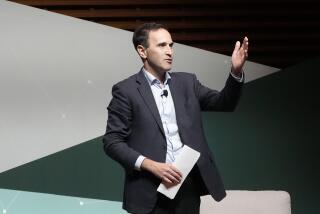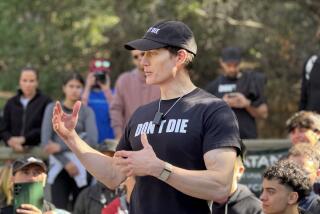‘Duh’ science: Why researchers spend so much time proving the obvious
Medical researchers have unlocked the human genome, wiped out smallpox and made great strides in the fight against AIDS.
They have also published studies revealing that:
Alcohol increases reaction time and errors during decision-making.
• People who live in safe, well-lit neighborhoods are more likely to walk and get exercise.
• College drinking is just as bad as researchers thought, but not worse than expected (try pondering that one after chugging a beer).
Well, duh, you might think — and you wouldn’t be the first. The practice of hypothesizing, testing and publishing the seemingly obvious is widespread.
Accounts of “duh” research abound. There are studies showing that driving ability worsens in people with early Alzheimer’s disease, that women who get epidurals experience less pain during childbirth than women who don’t, that young men who are obese have lower odds of getting married than thinner peers, that making exercise more fun might improve fitness among teens.
These reports make eyes roll. Anti-tax crusaders fume at the thought of government money spent to “discover,” once again, that stress in childhood leads to depression in adults, or that not having health insurance affects cancer survival. Just last week, a report from Sen. Tom Coburn (R-Okla.) lambasted the National Science Foundation for funding what he considers wasteful projects, including $2 million to figure out that people who upload pictures to the Internet from the same place at the same time are usually friends.
But there’s more to duh research than meets the eye. Experts say they have to prove the obvious — and prove it again and again — to influence perceptions and policy.
“Think about the number of studies that had to be published for people to realize smoking is bad for you,” said Ronald J. Iannotti, a psychologist at the National Institutes of Health. “There are some subjects where it seems you can never publish enough.”
Indeed, people are still arguing about cigarettes almost 50 years after the U.S. surgeon general first linked their use to cancer and lung disease. In a recent issue of the Canadian Medical Assn. Journal, a detailed analysis painstakingly laid out a notion that most take for granted: that secondhand smoke in cars is bad for children.
Duh.
Or consider the case of Harvard sleep expert Dr. Charles Czeisler, who has spent about $3 million over the years demonstrating over and over that doctors who don’t get enough sleep make mistakes on the job.
This seems painfully clear. But getting the medical establishment to start believing it — much less change the rules governing doctors’ working hours — has taken Czeisler the better part of three decades. Long shifts for interns and residents are a staple of hospital culture.
When Czeisler presented evidence that workers on rotating shifts at a chemical plant suffered on disrupted sleep, the medical establishment said that doctors were different. When he published results showing that physicians’ 24-hour-plus shifts contributed to car accidents and attention lapses at work, some acknowledged it might be true — but not for them.
Everyone had an anecdote. Czeisler had data. “It was dismissed out of hand,” he said. “They use the same argument over and over, even when we’ve tested it. It drives me up the wall.”
In 2008, the Institute of Medicine issued guidelines calling for limiting interns’ and residents’ shifts to 16 consecutive hours. Last year, authorities did cut back to 16 hours — but only for interns. Why? In part because that’s who Czeisler had studied.
“I was astonished,” said Czeisler, who is now researching whether residents’ performance also is affected by lack of sleep. “I can’t believe we have to do this extra study.”
There’s another reason why studies tend to confirm notions that are already widely held, said Daniele Fanelli, an expert on bias at the University of Edinburgh in Scotland. Instead of trying to find something new, “people want to draw attention to problems,” especially when policy decisions hang in the balance, he said.
Kyle Stanford, a professor of the philosophy of science at UC Irvine, thinks the professionalization of science has led researchers — who must win grants to pay their bills — to ask timid questions. Research that hews to established theories is more likely to be funded, even if it contributes little to knowledge.
Marc Abrahams, creator of the Ig Nobel Prizes (which honor improbable research, including a study that found nose-picking was common among teens), adds that scientists get promotions only if they crank out a lot of research papers — publish or perish, as the saying goes. “It’s the way the industry is set up,” he said.
The sheer number of studies that get published suggests that Abrahams might be onto something. A recent paper in the journal PLoS Medicine reported that medical journals publish the results of 75 clinical trials and 11 systematic reviews of trials every day. There is “an overload of unfiltered information,” the authors wrote. It can’t all be groundbreaking.
Sometimes, a study that seems poised to affirm the conventional wisdom produces a surprise. Many have taken the value of popular programs like DARE — in which police warn kids about the dangers of drug use — as an article of faith. But Dennis Rosenbaum of the University of Illinois at Chicago and other researchers have shown that the program has been ineffective and may even increase drug use in some cases.
Iannotti of the NIH recently revealed in the Journal of Adolescent Health that victims of cyber-bullying are more depressed than the bullies who torment them.
He says the research, which cost about $6,400, was “kind of a duh, but not exactly,” because it was one of the first studies characterizing cyber-bullying — and because studies on traditional bullying had shown bullies to be depressed too.
That might come as a surprise to many people. But even if initial findings seem self-evident, Iannotti said, “you still need to establish the facts. That’s how science moves forward — incrementally.”
Still, some wonder whether incremental is just a stand-in for inconsequential. At what point is it absurd to spend months determining that “pilots who drink and drive are at higher risk to crash planes,” as a study in the journal Accident Analysis & Prevention reported in 2005?
Deficit hawks worry that the government spends too much on seemingly pointless research.
One of them is Steve Ellis, vice president of Taxpayers for Common Sense, a nonpartisan watchdog group that hands out the Golden Fleece Awards. The awards have exposed such follies of public expenditure as $219,592 to develop a curriculum to teach college students how to watch television and $6,000 to help explain how to buy a bottle of Worcestershire sauce.
Ellis said that funding basic research remains a crucial area for the government. “But not every study is equally worthwhile,” he said. “If the public sees things that appear to be ridiculous, it’s going to be harder and harder to get dollars for critical research.”
Mark Weiss, division director for behavioral and cognitive sciences at the National Science Foundation, acknowledged that in a large research project, some results may seem obvious when removed from their larger context.
“Is there some research that treads old ground? Well, sure,” he said. “Like Garrison Keillor says, everyone can’t be above average.”







